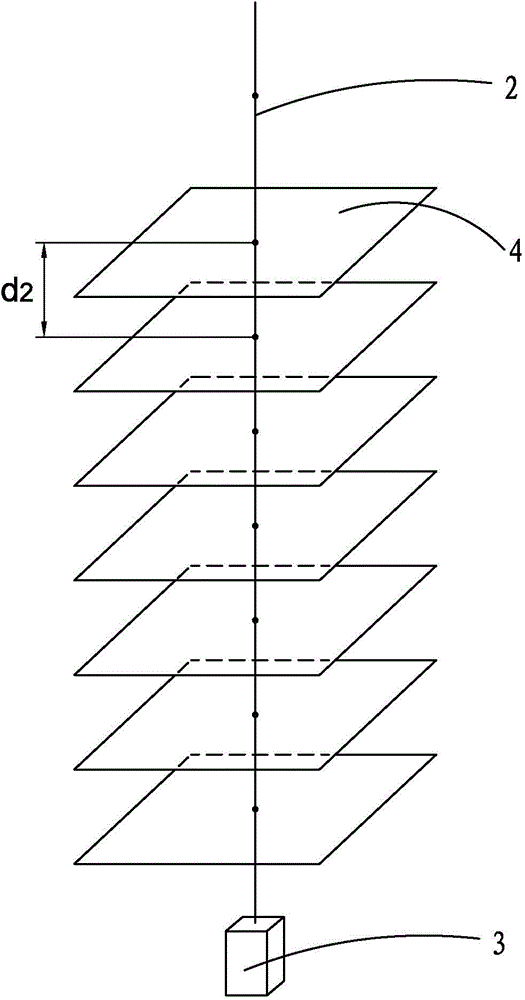Scale breeding method for south-migrated stichopus japonicus
A technology of ginseng and cultivating ponds, applied in climate change adaptation, fish farming, applications, etc., can solve the problems of high breeding costs and high mortality, and achieve the effect of avoiding high breeding costs.
- Summary
- Abstract
- Description
- Claims
- Application Information
AI Technical Summary
Problems solved by technology
Method used
Image
Examples
Embodiment 1
[0030](1) From March 15th to 20th, 2008, mature individuals of sea cucumbers grown in sea areas for two years were selected from Nanri Island in Fujian and Yantai in Shandong as parent ginseng (among them, 50% of the ginseng were collected from Nanri Island in Fujian and grown in the sea area. 2-year-old mature sea cucumber individuals, 50% of which are collected from mature sea cucumber individuals grown for 2 years in the Yantai sea area of Shandong). The ginseng was transported to Shengde Abalone Seed Breeding Field in Xiuyu District, Putian City, Fujian Province by means of low-temperature and wet transportation;
[0031] (2) Put the selected parent-ginseng into the parent-ginseng cultivation pool, and then stimulate the parent-ginseng to discharge sperm eggs by raising the temperature. The heating process is an equal gradient temperature increase, that is: the initial temperature is 15.5°C, the end temperature is 22.5°C, and the heating rate is 1 °C / day; after the tempe...
Embodiment 2
[0036] (1) From March 10th to 15th, 2009, mature individuals of sea cucumbers grown in sea areas for two years were selected from Nanri Island, Fujian Province, and Dalian, Liaoning Province as parent ginseng (50% of which were collected from Nanri Island sea area of Fujian Province and grown 2-year-old mature sea cucumber individuals, 50% of which are collected from mature sea cucumber individuals grown for 2 years in the sea area of Dalian, Liaoning). The ginseng was transported to the Huayang Sea Treasure Seed Breeding Field in Xiuyu District, Putian City, Fujian Province by means of low-temperature and wet transportation;
[0037] (2) Put the selected parent-ginseng into the parent-ginseng cultivation pool, and then stimulate the parent-ginseng to discharge sperm eggs by raising the temperature. The heating process is an equal gradient temperature increase, that is: the initial temperature is 15.5°C, the end temperature is 22.5°C, and the heating rate is 1 °C / day; afte...
Embodiment 3
[0042] (1) From March 5th to 10th, 2010, mature individuals of sea cucumbers grown in the sea area for two years were selected from Nanri Island, Fujian Province and Qingdao, Shandong Province as parent ginseng (50% of which were grown in the sea area of Nanri Island, Fujian Province) 2-year-old mature sea cucumber individuals, 50% of which are collected from mature sea cucumber individuals grown for 2 years in the sea area of Qingdao, Shandong). The ginseng was transported to the Pengfei Seafood Seed Breeding Farm in Xiuyu District, Putian City, Fujian Province by means of low-temperature and wet transportation;
[0043] (2) Put the selected parent-ginseng into the parent-ginseng cultivation pool, and then stimulate the parent-ginseng to discharge sperm eggs by raising the temperature. The heating process is an equal gradient temperature increase, that is: the initial temperature is 15.5°C, the end temperature is 22.5°C, and the heating rate is 1 °C / day; after the tempera...
PUM
 Login to View More
Login to View More Abstract
Description
Claims
Application Information
 Login to View More
Login to View More - R&D
- Intellectual Property
- Life Sciences
- Materials
- Tech Scout
- Unparalleled Data Quality
- Higher Quality Content
- 60% Fewer Hallucinations
Browse by: Latest US Patents, China's latest patents, Technical Efficacy Thesaurus, Application Domain, Technology Topic, Popular Technical Reports.
© 2025 PatSnap. All rights reserved.Legal|Privacy policy|Modern Slavery Act Transparency Statement|Sitemap|About US| Contact US: help@patsnap.com


